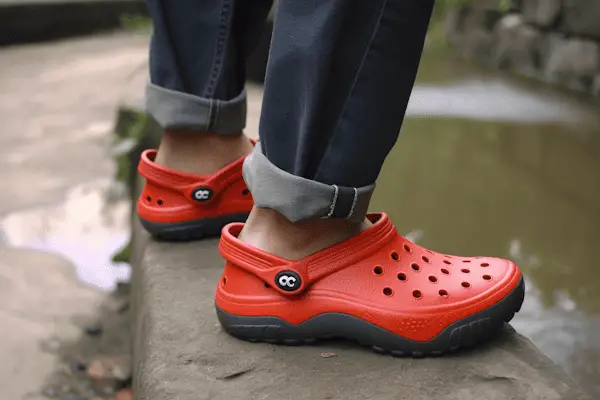Some people just love Crocs and couldn’t imagine wearing anything else. But, can you go hiking in Crocs?
Hiking in Crocs can provide breathable, lightweight comfort but may compromise on foot support, traction, and protection, making it potentially risky on rugged terrain or long-distance hikes.

Advantages of Hiking In Crocs
The seven main advantages of hiking in Crocs are:
- Comfort
- Weight
- Breathability
- Water-Friendly Design
- Ease of Use
- Affordability
- Low Maintenance Requirements
Kick Back and Relax: The Comfort Factor of Hiking in Crocs
So, one of the coolest things about Crocs is just how comfortable they are. They’re made from this special foam stuff called Croslite, which is pretty neat because it kind of molds to your foot. It’s like your foot gets a personalized cushion – imagine walking on a cloud! Especially on those easy-going, short hikes, it’s like a mini vacation for your feet. Plus, unlike some tight shoes that squeeze your toes, Crocs give them plenty of space to wiggle around. But hey, while all that comfort is a big win, don’t forget that they don’t have the hardcore structure and support that you get with standard hiking boots, so they might not cut it for those tough, long hikes.
Travel Light, Feel Right: The Low-Down on Crocs’ Lightness
So, here’s another thing that hikers dig about Crocs – they’re super lightweight. I mean, compared to those heavy-duty hiking boots, it’s like you’re wearing feathers on your feet! This can really make a difference when you’re out there on the trail because lighter footwear means less leg strain, which equals more fun and less fatigue. That’s a win-win, right? But remember, while saving on weight is cool, it’s because Crocs aren’t packed with all that heavy protective material you find in standard hiking boots. So they might not be the best bet for those tricky terrains where you need some serious foot protection.
Keeping it Cool: The Breathability Perks of Crocs
Now, let’s talk about another thing that makes Crocs a hit with some hikers: breathability. You see, Crocs have these little ventilation holes that let the airflow in and out, keeping your feet cool and dry. That’s a biggie because, trust me, no one likes sweaty feet, especially on a hike. And dry feet are less likely to get blisters, so that’s another bonus. It’s like your feet get their own mini air conditioning system!
“It’s like your feet get their own mini air conditioning system!”
But, just a heads-up, while all that airflow is great, remember that those holes also let in small stones, dirt, and water. So, if you’re planning a trek where you’d rather keep the elements out, you might want to reconsider your footwear.
Water Woes? Not Here: Crocs’ Splash-friendly Side
Here’s something else that’s super cool about Crocs – they’re totally down with getting wet. If your hike involves any water crossings, a sudden downpour, or just stepping in a puddle, Crocs are like, “Bring it on!” They dry out really fast, and they aren’t going to get ruined by a bit of water, unlike some other footwear. It’s like having duck feet, in a way. But hey, keep in mind that while being water-friendly is all well and good, Crocs aren’t waterproof, so your feet will get wet. Also, those little ventilation holes we talked about? They’ll let mud into your Crocs which doesn’t feel all that great.
Slide In, Slide Out: The No-fuss Nature of Crocs
Here’s another sweet deal about Crocs: they’re ridiculously easy to wear. Seriously, it’s just slide in, slide out, no fuss, no problem. You know those moments when you need to take a quick break during a hike? Or when you get to your campsite and can’t wait to kick off your shoes? With Crocs, it’s a breeze. Plus, at the end of the day, when you’ve got dirt or sand in your shoes, it’s way easier to get it out. But remember, that slide-in, slide-out design means they might not stay on as securely as laced-up boots, especially on steep slopes or if you’re moving quickly. So, if you’re going for a challenging hike, those traditional hiking boots might still be your best bet.
Budget-friendly Adventure Gear: The Wallet Appeal of Crocs
Let’s talk cash for a sec. If you’re an occasional hiker or just starting out, you might not want to splurge on those high-end hiking boots. And that’s where Crocs come in. They’re pretty budget-friendly and still, give you a fair bit of comfort and practicality for those leisurely hikes. You get to save some dough and still enjoy your outdoor adventure. But remember, as with most things, you get what you pay for. Crocs might be easier on the wallet, but they lack the specialized features and durability of a solid pair of hiking boots. If you’re heading out on a tough, long trek, investing in proper footwear could be a wise move.
Low-key and Low Maintenance: Crocs’ Hassle-Free Upkeep
Lastly, one of the biggest perks of Crocs? They’re seriously low maintenance. Got them dirty? No problem – a quick rinse and they’re good as new. They’re pretty tough cookies too – they resist wear and tear pretty well. So, you won’t find yourself needing to replace them as often as some other shoes. This makes them a great choice for those casual, relaxing hikes where you just want to chill and not worry about keeping your gear in tip-top shape. But, while it’s awesome that they’re so easy to care for, remember that they might not provide the long-term durability and protection of specialized hiking boots, especially if you’re into serious trekking. Sometimes, a bit of maintenance and care for the right gear is worth the effort.
Disadvantages of Hiking In Crocs
Of course, hiking in Crocs isn’t all good. Here are 7 disadvantages of hiking in Crocs:
- Lack of Support
- Limited Protection
- Reduced Traction
- Potential for Blisters
- Risk of Losing Them
- Bad in Cold Weather
- Lack of Durability
Where’s the Support? The Downside of Crocs
So, first things first, one drawback with Crocs is that they don’t offer much in the way of support. You see, hiking boots are designed with good ankle and arch support to handle those uneven trails, but Crocs? Not so much. This means you’re at a greater risk of twisting an ankle or ending up with aching feet, especially if you’re walking on rough or uneven ground. So, while they’re comfy for easy walks, you might want to stick to boots for the more challenging hikes.
Feeling a Bit Exposed: The Protection Issue with Crocs
Now, let’s talk about protection, or rather, the lack of it when you’re hiking in Crocs. Unlike boots, Crocs are pretty open, which means your feet are more exposed to the elements. Sharp rocks, prickly thorns, unfriendly plants, or even biting insects could turn your pleasant hike into a not-so-fun experience. And remember those cool ventilation holes in Crocs? They can let small pebbles or other debris sneak in and cause discomfort.
Slip and Slide: Traction Troubles with Crocs
Another thing to consider is traction. Hiking boots are known for their good grip, helping you to navigate slippery or steep trails. Crocs, on the other hand, don’t quite measure up in this department. Their soles might be a bit more slippery, which could make your hike more challenging, and not in a good way. Especially on a rainy day or on loose gravel, you’ll want to think twice about wearing Crocs.
Blister Territory? The Fit and Rub of Crocs
While Crocs are generally comfortable, there’s a chance the loose fit could cause your foot to slide and rub against the shoe, and that’s prime blister territory. This is especially likely on longer hikes where you’re on your feet for extended periods. So, while they might feel like a dream on those short walks, they might not be your best friend on those long-distance hikes.
Footloose and Croc-less: The Risk of Losing Your Crocs
Here’s something else to consider: Crocs are slip-ons, which means they can, well, slip off. Imagine you’re crossing a stream or trudging through mud, and whoops – there goes your shoe! It can be a bit of a hassle, especially if you’re in a tricky spot. So, for those more challenging hikes, you might want to opt for boots that stay securely on your feet.
A Cold Reality: Crocs in Chillier Climes
Crocs and cold weather? Not the best combo. These shoes are definitely not designed to keep your feet warm, which can be a problem if you’re hiking in colder conditions. No one wants freezing feet on a hike, right? So, when the temperatures drop, you’re better off leaving your Crocs at home and opting for insulated hiking boots instead.
Are They Tough Enough? Durability Doubts with Crocs
Lastly, while Crocs are pretty tough for casual use, they might not be up to the task of heavy-duty hiking. Rough terrain, sharp rocks, and intensive use can take a toll on them. In the long run, traditional hiking boots are typically more durable and better equipped to handle the challenges of serious hiking. So, while Crocs are great for easy-going walks and casual strolls, if you’re planning a hardcore hiking adventure, proper hiking boots are probably the way to go.
My Favorite Alternative to Hiking In Crocs
If you’ve read my post on hiking in Tevas, you probably already know what my favorite alternative to Crocs is. Teva has a few different options, but the Teva Omnium is the obvious alternative to Crocs.
When it comes to hiking, Tevas have a clear edge over Crocs. Firstly, Tevas are designed specifically for outdoor activities, including hiking. They offer superior support and stability with features like adjustable straps that secure your feet in place, providing excellent ankle support and reducing the risk of twists or sprains on uneven terrain. Unlike Crocs, Tevas are equipped with rugged soles that offer excellent traction, allowing you to confidently navigate slippery surfaces and rocky trails. Whether you’re hiking in dry or wet conditions, Tevas are designed to provide reliable grip and prevent slips, making them a safer option for adventurous treks.
Secondly, Tevas excel in providing enhanced protection. With their closed-toe designs, Tevas shield your feet from rocks, roots, and other potential hazards on the trail. This extra protection significantly reduces the risk of stubbing your toes or suffering injuries from sharp objects. Furthermore, Tevas are often constructed with durable materials, ensuring longevity and resistance to wear and tear even during intense hikes. So, if you’re planning a hiking adventure and seeking footwear that combines support, traction, and protection, Tevas are undoubtedly a superior choice over Crocs.
